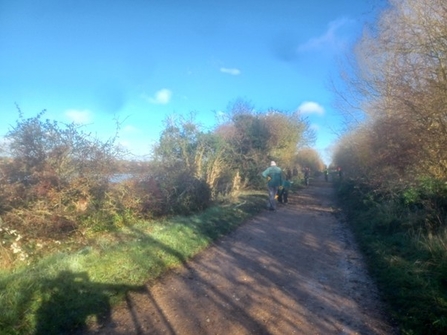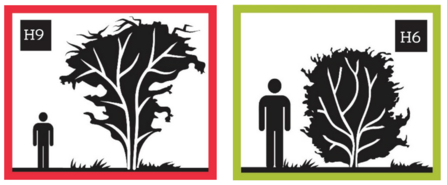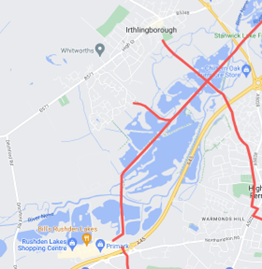
Volunteers work to lay hedgerow along the Greenway, improving the path for many species of wildlife, and for people - Pete Bray

Volunteers work to lay hedgerow along the Greenway, improving the path for many species of wildlife, and for people - Pete Bray
In a job where there’s no such thing as completing work, only doing what you can with the time and resources available, winter truly is the busy season for the practical conservationist. Having thought a month had gone by since my last article, it seems four have snuck past; September feels like yesterday. But the time has been well spent by volunteers and staff out on the reserves. Nene Wetlands and Summer Leys are both looking quite different in many places – hedges laid, trees coppiced, scrub cut and burned, willow in reedbed slowed with the bowsaw and the chainsaw.
While the previous blog discussed structural diversity and how important it is for biodiversity, this one is specifically about paths, particularly the Greenway at Nene Wetlands.
The Greenway is a network of paths that runs along the old railway line from what is now Rushden Lakes, northeast to Stanwick Lakes and beyond. It also includes the spur line up to Randall Close, and Kings Meadow Lane - the path between Irthlingborough and Higham Ferrers. These paths are the widest, most well constructed paths on the reserve, and also see the most human traffic.
Paths on nature reserves clearly serve a purpose for humans, but they’re also great opportunities for providing important space for wildlife. Where wide paths are surrounded by woodland, the paths are known as woodland rides. From the sunny, disturbed edges of the path, where tiny plants make use of the open ground, up to the high canopy of mature trees, woodland rides should form a V shape when you look down them. This range of heights (which we call structural diversity) means the best possible range of homes for plants, insects like butterflies, birds, mammals and other forms of wildlife. Rides are best for wildlife when they adhere to five principles:
In order to create this wide, V shaped structure with variation in vegetation height, we must manage both the grass (and associated wildflowers) and the trees.

An example of an idealised Woodland Ride, maximising space for a wide range of wildlife. From Enact Magazine (now Conservation Land Management) Vol 1
We mow and collect the grass on average every other year, switching from one side of the path to the other roughly every 50 metres. This creates a zigzag of taller grass, and shorter mown grass. The taller grass is particularly important for overwintering insects, while mowing limits nutrient levels and stops scrub from taking over– both vital for many wildflowers. It’s also essential to collect the cut material – dropping it will create a mat that will eventually kill off the plants beneath. Anyone who has been on a long camping trip will know the yellowing square that can be left by a tent! This collected grass serves its own important purpose – piled up in heaps, it makes excellent grass snake habitat.
For the trees, we cut (or coppice) rectangles, usually 30 by 10 metres, removing most or all of the trees, to allow in light to the ground and the path beside. These are referred to as rideside scallops – traditionally these scallops were curved in shape, like a scallop shell. In the first year or so, we may see wildflowers emerging, or grasses, and in time the cut trees will regrow from their base creating dense shrubs, great hiding and nesting places for birds and small mammals. In 10 to 15 years’ time, the trees will be tall again and the process will start over. Freshly cut areas are spread out across the length of the path, to create as varied a structure as possible across the whole length of the Greenway.
For many places at Nene Wetlands including good stretches of the Greenway, this management style will have benefits for wildlife, but it will also benefit people. Overhanging trees can fall over paths, blocking access, and they also mean paths are darker, wetter and muddier. Where cyclists and walkers both use paths, cutting back trees also opens up views round corners, making paths safer.
For some of the Greenway, there are no trees behind those right next to the path. At the north east end of the reserve, where open ground is the main objective, the tree lined Greenway is in fact, two hedges with a path in the middle. Due to being left to their own devices however, the hedges have become tall, with little undergrowth, more like a row of trees. Trees are of course great things in themselves, but they are less valuable to wildlife in this state than a dense hedge, and provide a far less effective corridor to allow wildlife to move around.

The Greenway hedgerows are now overgrown and with little or no undergrowth, like H9 above. Rows of trees with no undergrowth are not as valuable as a wildlife corridor as dense hedgerow, like H6, as hedges that are dense at the base provide more protection to a wider range of species. From PTES, hedgerowsurvey.ptes.org/hedge-structures
By laying or coppicing these trees, we start a cycle much like that of the rideside scallops described above. To make the structure as varied as possible, short sections of roughly 30 metres are cut into mature hedgerow. Where trees are too mature to lay, they are coppiced to ground level and any gaps are ‘gapped up’ with fresh hedgerow saplings, to make a dense, continuous corridor.
The Greenway at Nene Wetlands is in many ways the epitome of the Trust’s mission – to protect and restore wild places for the benefit of people and wildlife. By managing the path-side vegetation, we create biodiverse corridors for nature, whilst making the paths safer and more enjoyable for people.
For more info on hedge management and the benefits to wildlife, visit PTES’ website
For more info on woodland management including ride management, RFS have a great leaflet

The Greenway at Nene Wetlands and surrounding areas- Google maps